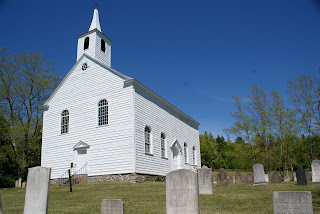Above: St Mary's Anglican, Auburn 1790
The interior is still in excellent shape and still retains its lovely gallery and lath and plaster barrel vault. More on this spectacular building next week in one of our building profiles. Thanks again to Roseann who kindly let us into the church and who gave us some wonderful background information. Above: the interior of St Mary's Auburn, looking west
After this, we went to Middleton to check out Old Holy Trinity Church of 1789. We were intrigued by the authenticity of the Gothic details as its date would put it at one of the earliest (if not the earliest) examples of the Gothic style in Canada.
Above: Old Holy Trinity, Middleton 1789
Thanks to Brian, we were able to enter the church to check it out and to look for proof about the authenticity of the pointed windows on the facade. The interior has been well kept and we were able to determine that the Gothic windows were, in fact, original! Quite a find! The nave has been nicely restored as seen below. We will also feature this building in a more detailed building profile some time in the near future.
Above: the nave of Old Holy Trinity looking east
As icing on the cake, we were also able to see Old St Edwards Church in Clementsport of 1797. This classically-inspired church was a real beauty including a south-side pedimented entrance and Palladian eastern window, though sadly we couldn't get in.
Above: Old St Edwards Church, Clementsport 1797
It was a great day for very old buildings and also an excellent way to wrap up our visit to Nova Scotia. All in all we visited just over 50 buildings in seven days, so we will be filling you in on the rest of our finds in the next little while.














Your archaeological assessment of Middleton's windows is supported by indirect evidence as well. If ecclesiology had made itself felt there at some date in the 19th century, and a Gothicization of the church had resulted, they wouldn't just change a couple of puny windows in the west end - they'd add a deep chancel, and chancel arch, and put lancets in the chancel, etc. So from that perspective too, it seems unlikely that the windows would be a later addition. The same argument can be made for Karsdale.
ReplyDeleteThe protracted (and imperfectly documented) building campaign at Middleton makes it hard to say for sure which windows are earlier. But it doesn't really matter. It seems safe to say that Gothic began appearing in the Annapolis Valley in the late 18th century, and that this likely marks its first appearance in British North America.
How was the food?
Nicely put, Peter! We were thinking along those lines as well.
ReplyDeleteAnd we didn't eat near any of these churches, but we did have a spectacular meal the night before in Wolfville - lobster linguine, yum!
Congrats on the blog. I see you have coined yourselves the Malcolmites...I thought followers of Malcolm X were called Malcolmites.
ReplyDeleteNevertheless, keep up the good work on pre-modern Canadian architecture!
There is, of course, one more source of evidence that needs to be checked in order to be 100% certain: the documents, which here would mean the vestry minutes. It's still possible (although I think quite unlikely) that some later re-building program of the west end could be recorded, which would re-date the windows. I haven't checked the Middleton minutes, but I may manage it before leaving Nova Scotia. I have checked Karsdale's and found no mention of new windows; until someone does the same with Middleton there will remain a small asterisk beside it in my mind.
ReplyDeleteLobster linguine? Sounds good! Wolfville is a tiny place, but just might have more good restaurants per capita than anywhere else in Canada.
I am a coal miner's daughter and a member of St. Andrew's Wesley United Church in Springhill, Nova Scotia. I am so disappointed that you apparently did not visit Springhill during your Nova Scotia tour. We have a beautiful Anglican church designed by William Harris and a Roman Cahtolic Church with magnificent stained glass windows as well as frescoes depicting the Stations of the Cross. My interest, however, is directed to our United Church which is built on the Akron plan. I would be very interested in obtaining any additional information on this design and to learn something of the nature of our stained glass windows. We have two panels, each 17 feet by 7 which are original to the church (cornerstone 1913, opened in March 1914.) I am attempting to relate the history of the church to that of the town. Both are deceptively simple; both have been drenched in tragedy and dusted in miracles. Any info you could provide would be sincerely appreciated.
ReplyDeleteHi Elaine,
ReplyDeleteUnfortunately we did not make it Springhill on this trip, but next time we'll try to get there - it sounds like there are lots of great churches.
Since we didn't make it there, I don't have info. regarding the specific churches you mentioned, but you could try looking up Robert Tuck, he has written several books about Nova Scotia churches.
You could also try to get the vestry minutes. The minutes should give you historical info. in detail and will also (hopefully) help you with the stained glass window research as well.
The Canadian Stained Glass Registry might also be of use to you; it has a bibliography and information about different stained glass artists and manufacturers.
The registry can be found at: http://www.yorku.ca/rsgc/index.html
For the Akron plan there are some good articles on-line that you could use to help you get started. For example: http://www.sacredplaces.org/PSP-InfoClearingHouse/articles/American%20Religious%20Buildings.htm
I hope this can get you started, good luck,
Candace.